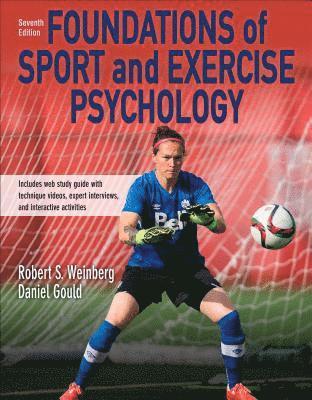
- Format
- Mixed media product
- Språk
- Engelska
- Antal sidor
- 680
- Utgivningsdatum
- 2019-01-21
- Upplaga
- 7 ed
- Förlag
- Human Kinetics
- Illustratör/Fotograf
- 77 Illustrations
- Illustrationer
- 77 Illustrations
- Dimensioner
- 277 x 216 x 30 mm
- Vikt
- Antal komponenter
- 1
- Komponenter
- Contains 1 Digital online and 1 Paperback / softba
- ISBN
- 9781492572350
- 1884 g
Foundations of Sport and Exercise Psychology 7th Edition With Web Study Guide-Paper
- Skickas från oss inom 5-8 vardagar.
- Fri frakt över 249 kr för privatkunder i Sverige.
Passar bra ihop
De som köpt den här boken har ofta också köpt There Are Moms Way Worse Than You av Glenn Boozan (inbunden).
Köp båda 2 för 1953 krKundrecensioner
Fler böcker av författarna
-
Foundations Of Sport And Exercise Psychology
Robert S Weinberg, Daniel Gould
-
The Art of the Pulps: An Illustrated History
Douglas Ellis, Ed Hulse, Robert Weinberg
-
Blood Libel in Late Imperial Russia
Robert Weinberg
-
Computers Of Star Trek
Lois Gresh, Robert Weinberg
Övrig information
Robert Weinberg has over 40 years' experience in both academic and applied sport psychology. He has written more than 150 journal articles, as well as books, chapters and applied articles for coaches and athletes. Daniel Gould has taught sport psychology for more than 35 years. Gould was the founding co-editor of The Sport Psychologist and has published more than 200 articles on the subject of sport psychology.
Innehållsförteckning
Part I. Beginning Your Journey Chapter 1. Welcome to Sport and Exercise Psychology Defining Sport and Exercise Psychology Specializing in Sport Psychology Distinguishing Between Two Specialties Reviewing the History of Sport and Exercise Psychology Focusing on Sport and Exercise Psychology Around the World Learning Aids Chapter 2. Science and Professional Practice of Sport and Exercise Psychology Bridging Science and Practice Choosing From Many Sport and Exercise Psychology Orientations Understanding Present and Future Trends Learning Aids Part II. Learning About Participants Chapter 3. Personality and Sport Defining Personality Understanding Personality Structure Studying Personality From Six Viewpoints Measuring Personality Using Psychological Measures Focusing on Personality Research Examining Cognitive Strategies and Success Identifying Your Role in Understanding Personality Learning Aids Chapter 4. Motivation Defining Motivation Reviewing Three Approaches to Motivation Building Motivation With Five Guidelines Developing a Realistic View of Motivation Understanding Achievement Motivation and Competitiveness Identifying Four Theories of Achievement Motivation Developing Achievement Motivation and Competitiveness Using Achievement Motivation in Professional Practice Learning Aids Chapter 5. Arousal, Stress, and Anxiety Defining Arousal and Anxiety Measuring Arousal and Anxiety Defining Stress and Understanding the Stress Process Identifying Sources of Stress and Anxiety Connecting Arousal and Anxiety to Performance Applying Knowledge to Professional Practice Learning Aids Part III. Understanding Sport and Exercise Environments Chapter 6. Competition and Cooperation Defining Competition and Cooperation Viewing Competition as a Process Reviewing Studies of Competition and Cooperation Determining Whether Competition Is Good or Bad Enhancing Cooperation Learning Aids Chapter 7. Feedback, Reinforcement, and Intrinsic Motivation Principles of Reinforcement Approaches to Influencing Behavior Guidelines for Using Positive Reinforcement Guidelines for Using Punishment Behavior Modification in Sport Behavior Modification and Cognitive Behavior Therapy Intrinsic Motivation and Extrinsic Rewards Cognitive Evaluation Theory How Extrinsic Rewards Affect Intrinsic Motivation in Sport Strategies for Increasing Intrinsic Motivation Flow-A Special Case of Intrinsic Motivation Learning Aids Chapter 8. Diversity and Inclusion Definition of Culture, Diversity, Inclusion, and Cultural Competence Diversity and Inclusion Research in Sport and Exercise Benefits of Diversity and Inclusion Strategies for Diversifying Sport and Physical Activity and Creating Inclusive Environments Learning Aids Part IV. Focusing on Group Processes Chapter 9. Team Dynamics and Cohesion Recognizing the Difference Between Groups and Teams Identifying Three Theories of Group Development Understanding Group Structure Creating an Effective Team Climate Maximizing Individual Performance in Team Sports Definition of Cohesion Conceptual Model of Cohesion Tools for Measuring Cohesion Relationship Between Cohesion and Performance Other Factors Associated With Cohesion Strategies for Enhancing Cohesion Guidelines for Building Team Cohesion Learning Aids Chapter 10. Leadership Definition of Leadership Approaches to Studying Leadership Sport-Oriented Interactional Approaches to Leadership Research on the Multidimensional Model of Sport Leadership Leadership Training Interventions Four Components of Effective Leadership The Art of Leadership Learning Aids Chapter 11. Communication Understanding the Communication Process Sending Messages Effectively Receiving Messages Effectively Recognizing Breakdowns in Communicati
Du kanske gillar
-
Lone Rider
Elspeth Beard
Häftad -
20,000 Cows!
Alex Cheddar
Häftad -
We Need Your Art
Amie McNee
Inbunden -
Cozy Corner
Coco Wyo
Häftad


